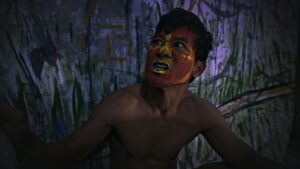Artist & writer Chath pierSath at London Art Gallery
Chath pierSath, a writer and artist who has been a contributor to this blog, is featured through December 21 in a current exhibition of the art gallery Niru Ratnam in London. See the project description below. Here’s a link to the website.
From the website of Niru Ratnam Gallery in London:
“Niru Ratnam will present the premiere of Kutluğ Ataman’s new work ‘Snow White’ this November in London. Recalling earlier key works by Ataman such as ‘kutluğ ataman’s semiha b. unplugged’ (1997), Ataman turns his camera onto a subject whose recollection of their life interweaves a deeply personal account with the political history of a nation. Ataman’s subject, the Cambodian-born artist Chath pierSath is portrayed giving a powerful and unflinching stream of consciousness that circles around the traumatic events he suffered as a child caught in the Cambodian Civil War. pierSath evokes a desperate time trying to survive under the Khmer Rouge, who were responsible for the deaths of nearly a quarter of the Cambodian population during their brutal four-year rule.
pierSath’s retells his devastating account of his childhood from within a claustrophobic space that looks like a small room made from unstretched canvas, some of which has been painted on. As he talks of his family, he makes small puppets from the material scattered around him and the effort of talking about this time clearly takes a toll on him. As viewers, we are witness to a vivid and difficult reliving of trauma. pierSath not only talks of his family, the arrival of the Khmer Rouge and subsequent events but at times inhabits different persona such as his mother. The tone is anguished, direct and powerful.
The fairy-tale of Snow White becomes a loose structuring device as pierSath retells his story slipping between identifications with the characters and historical subjects as well as how he identifies and ultimately rejects the fairytale. The experience of watching pierSath is discomforting as he seems at times overwhelmed by both his surroundings as well as the memories that he evokes. It is a strong antidote to the tidied up and presentable accounts of war trauma that are common in the western world. In these accounts, from aid agencies, news reports, social media warriors and celebrities with a cause, ‘victims’ of war crimes and trauma are passive ciphers to be first pitied, then perhaps funded by aid and then finally ignored as the west turns its gaze to the next non-western catastrophe. That historical actions by western nations largely lie at the root of those problems tends to be ignored. pierSath’s searing testimony insists on the presentness of those traumas, the fact that they cannot simply be tidied away. These are histories that are still alive in the present day, inexorably in the lives of survivors.
Ataman will also be exhibiting his ten-screen work ‘fff’ (2009) in the ground floor gallery, a work that originally premiered at the Whitechapel Gallery. The title of an abbreviation of ‘found family footage’, and the work consists of images drawn from the collection of home movies of two English families shot in the 1950s and 1960s. A set of ten different scores composed by Michael Nyman accompanies each of the ten films which are of different lengths so that each score falls out of sync with each other as the work progresses. The result is a complex montage of images and music where memory is presented as both fragmented, contradictory and re-constructed by both subject and other.
‘fff’ might at first be understood as an elegiac work made up of quintessentially English vignettes from a seeming lost age. However, Ataman’s viewpoint is that of an outsider looking in; born in Turkey the artist made London his home in the early part of the twenty-first century before returning to Turkey in 2012. The two families that we see in ‘fff’ always remain at a distance to the viewer, an effect that is heightened by Nyman’s soundtracks that never resolve themselves.
Together ‘Snow White’ and ‘fff’ ask questions about what it is to consider the pasts of ourselves and others, and how intertwined questions of individual identities are bound up with the nations, cultures and localities that shape us. Each work gestures at the impossibility of arriving at a resolution, of reconciling our pasts with our precarious present.”
